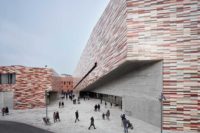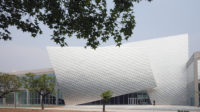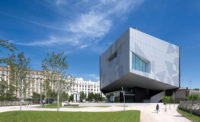Florence
It’s not always easy to be an architect in modern Italy, where contemporary design must measure itself against the weight of historic patrimony. That was clearly the case for the Florentine studio Avatar Architects when it won the commission to install the city’s collections of 20th-century Florentine art in a minor Renaissance masterpiece, Michelozzo’s Hospital of San Paolo, located in the Piazza of Santa Maria Novella. The intervention had to be reversible—and thus provisional. Working with bursts of color, immersive lighting effects, and exquisitely crafted materials, Avatar connects with the original architect across the centuries while creating a sensitive environment for the works on display and the curatorial program.
Michelozzo is best known for his design of the Medici Palace in Florence. For San Paolo, he was inspired by Brunelleschi’s first work, the Ospedale degli Innocenti, for the stately cadences of rounded arches over classical columns of the entry loggia and cloister. The former hospital has housed different public schools since 1780, but fell into disrepair as plans for new uses dragged out for decades. Finally, municipal architects restored the building for the Museo Novecento (as the 20th century is termed in Italian), as well as a forthcoming photography museum in an adjoining space. Unfortun- ately, they added a few jarring details, enclosing the gallery of the cloister in glass with heavy framing, and adding clumsy railings to its open-air upper story.
The museum’s design team wisely left the magnificent loggia and cloister relatively empty, with the exception of a few sculptures and installations in the latter, and confined the museum to rooms on the second and third floors. In their role as exhibition designers, Nicola Santini and Pier Paolo Taddei, who founded Avatar in 2001, laid a “carpet” of dark steel plate flooring across the lower gallery of the cloister, just inside the entry, to create a path through the bookshop and ticketing areas to the worn stone staircase that leads to the second floor. The steel plate, with soundabsorbing padding underneath, covers the undistinguished tiles of the municipal restoration. It serves as an introduction to the steel floors in the rest of the exhibition spaces and asserts itself as a decidedly contemporary intrusion (recalling, for example, the steel-plate floor sculptures of Carl Andre) within the exquisitely proportioned order of the Renaissance cloister.
On the cloister’s second level, visitors encounter three deep metal portals painted brilliant orange, yellow, and red—that lead, with a flourish of theme-park mystery, into the dark, immersive exhibition spaces on either side of the main stair. Curator Valentina Gensini organized the works in reverse chronological order, so the first rooms are dedicated to recent art, maximizing the shock of transition. Things come to a climax with a hall dedicated to the pop and conceptual art of the 1960s and ’70s. Acrylic cylinders drop from the ceiling, piping in electronic music and contemporary sound bites, while drawings, posters, and documents crowd the black, spotlighted walls. Presiding over the space is the vibrantly colored Superarchitettura installation of 1966–67 by Archizoom, the avant-garde design studio. Clearly, this is the period with which the architects most identify. “We Italians have this complex of not being able to compete with the international scene,” says Santini, laughing as he notes that the ’60s Florentine collective was able to attract wide attention.
The architects have created a minimalist backdrop in the galleries, lining the existing walls with gypsum board to hide windows, moldings, and other distractions. For budgetary reasons, they had to leave the dropped ceilings and track lighting of the municipal restoration, and completed the project in just three months with a budget of $1 million. As the journey through the museum reels back in time, the spaces and the lighting brighten. In transitional areas of midcentury art, the white walls are accented with freestanding black metal panels—from which paintings hang—each supported on a wide, millimeters-thin steel base. Display cases and sculpture pedestals of medium density fiberboard, and carpet-covered benches, are similarly understated, but there are also flashy moments, as when a transparent screen drops from the ceiling to receive ghostly film projections of Florentine opera from the 1930s.
Another high point, the long hall over the loggia showcases a collection of early 20th-century art. Here Avatar subdivided the space only partially, with short panels, each cantilevered off the wall and supported on a thin steel leg. Though irregularly spaced, the panels respect the rhythm of windows overlooking the piazza, reestablishing a subtle connection with Michelozzo’s work.
Avatar joins other Italian architects who have crafted contemporary interventions for historic buildings, starting in the 1950s with Franco Albini’s Museum of the Treasury at the San Lorenzo Cathedral in Genoa, and Carlo Scarpa’s Castelvecchio Museum in Verona, as well as his Gallerie dell’Accademia and Palazzo Querini in Venice, among others. The studio is currently renovating the scholar’s library of the Uffizi, following in the footsteps of previous interventions there by Scarpa and others. Like them, Avatar uses the exceptional Renaissance architecture of the Museo Novecento as a frame for its own spatial explorations, establishing a dialogue that highlights the best qualities of both.
People
Architect:
Collaborators:
Municipality technical office:
Municipality general technical coordination:
Operational management of architectural works:
Photographer:
General Contractor: Client: Municipality of Florence Size:26,000 square feet Cost: $1 million Completion date: June 2014
|
Products
Exterior cladding
Doors
Interior finishes
Furnishings
Lighting |

















